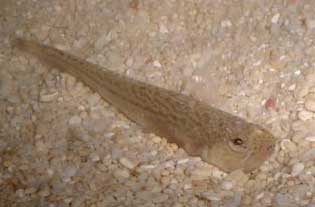 |
|
|
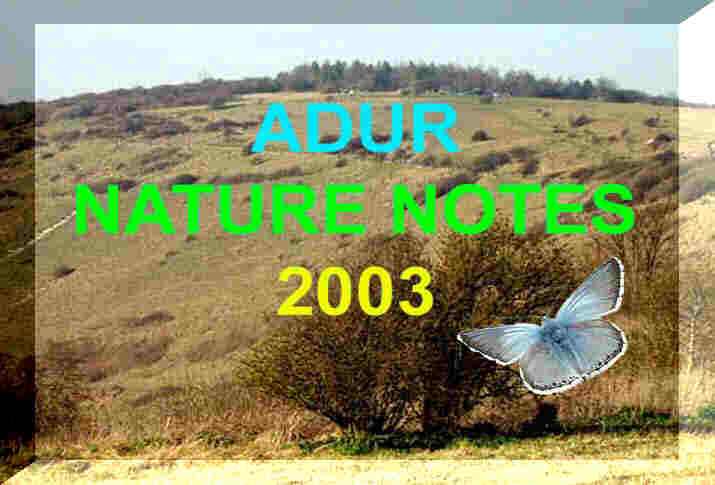 |
|
(ADUR VALLEY & DOWNS) |
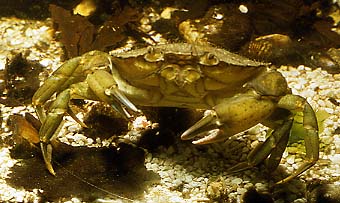 |

|
|
KINGSTON BEACH |
| Coastal Fringe |
| Chalk Downs |
| Intertidal (Seashore) |
| River Adur Estuary |
| River Adur Flood Plain |
| Sea (off Sussex) |
| Town & Gardens |
| Widewater Lagoon |
| ADUR NATURE NOTES |
| Lancing Beach |
|
|
Seashore: Southwick to Worthing, including Shoreham-by-Sea and Lancing
- Most of Shoreham Beach is
shingle giving way to sand which is visible at low tide. Groynes prevent
longshore
drift from the west.
In the entrance to Shoreham Harbour, there are artificial rocky* shores at Kingston Beach near the Lighthouse, and at the Old Fort beach on the other side of the River Adur. (* Larvikite, a type of syenite). These new rock groynes have now been extended the full length of Shoreham Beach and as far as Lancing Beach Green (May 2003).

Edible Prawn
- At Kingston
Beach there are extensive mussel beds, with
lots of periwinkles, although a spate of over-collection
during the 1980s decimated the beds and Serrated Wrack has now established
itself, because of the reduction of the grazing molluscs.
Shore Crabs are particularly abundant at Kingston because it is the entrance to the Adur Estuary.
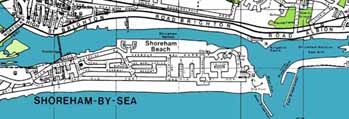
WILDLIFE REPORTS
EMail
Address for sending in wildlife reports from the lower Adur valley
Only
a selection will be included and only reports with the name of the reporter
WILDLIFE NEWS AND EVENTS
23 November 2004
A low 1.3 metre tide revealed a small expanse of sand on Shoreham beach and the area of beach by Widewater Lagoon. A few, at least three at a time, Sanderlings were feeding, repeatedly stabbing their small black beaks into the sand or on top of the sand for snippets. On the fine shingle (gravel), at least eight Turnstones were running around, their camouflage making them blend in with the background, but their whereabouts were given away as they moved.31 August 2004
The sand and rock shore at a low spring tide opposite Brooklands Boating Lake produced a few interesting critters under rocks. Another Vernal Swimming Crab, Liocarcinus vernalis, was discovered, scampering away and then burying itself rapidly and Daisy Anemones Cereus pedunculatus, in white and grey with a strange undulating appearance because of its position in a crevice, and a large Velvet Swimming Crab, Necora puber, were noteworthy. Fish included a few 5-Bearded Rocklings, Ciliata mustela.The more common crustaceans included small Common Hermit Crabs, Pagurus bernhardus, and Squat Lobsters, Galathea squamifera, a handful of small Long-legged Spider Crabs, Macropodia rostrata, and both species of Porcelain Crabs.
BMLSS: Crabs8 August 2004
A woman is stung by a Weever Fish, Echiichthys vipera, whilst bathing off Shoreham Beach.
Beware of the WeeverWeever Report by Ray Hamblett (Lancing Nature)
via BBC Southern Counties Radio
on the Adur Valley Biodiversity Smart Group
1 August 2004
Afternoon
The beach between Worthing and Lancing seems an unpromising area for rockpooling but it consistently provides a variety of some of the less usual small fish and crabs found between the tides. Katherine Hamblett and Tacita French discovered a young first year Worm Pipefish, Nerophis lumbriciformis, which is unusual this far east up the English Channel.
Liocarcinus vernalis Liocarcinus arcuatus There were unusual crabs as well as more common crustaceans like small Common Hermit Crabs, Pagurus bernhardus, and Squat Lobsters, Galathea squamifera. The itinerary of discoveries on the low spring tide can be found on the bucket page.
BMLSS: Crabs
Sea Anemones on this shore included at least a handful seen of Daisy Anemones Cereus pedunculatus, (with mauve/purple columns), and Snakelocks Anemones Anemonia viridis, which both reach their most easterly shore distribution at Lancing.
BMLSS: Sea Anemones
Halfbricking: Bucket of Critters29 July 2004
In the pool of water left by the receding tide underneath the middle groyne on Kingston Beach, a Snakelocks Anemone, Anemonia viridis, expanded its stinging tentacles. This anemone is unusual on this shore and reaches its easterly point of distribution on the northern coast of the English Channel at Shoreham. The pools also contained at least half a dozen small first year Corkwing Wrasse, Symphodus melops, which are a month earlier than usual between the tides.
BMLSS Sea Anemones11 July 2004
Shoreham Port Open Day
The Fish Festival display included a Triggerfish, Balistes capriscus, caught off Sussex the previous day, with a handful of other fish including Bass, two Stingrays, a Nursehound, Atlantic Eels, Corkwing Wrasse, Undulate Rays, one large Plaice and some invertebrate life with crustaceans that included Lobsters, Spider Crabs, Velvet Swimming Crabs, Common Hermit Crabs, Shore Crabs and molluscs including live Scallops.The Triggerfish (photographed above) swam around occasionally rising to the surface and expelling water from its mouth. It did not appear to be in discomfort and looked in a healthy condition.
At just after nine in the morning a single Peregrine Falcon flew around the Power Station Chimney and there were hundreds of Moon Jellyfish, Aurelia aurita, in the canal section of the harbour.
1 July 2004
Although a batch of low tides started today, the excessive amount of seaweed washed up on the shingle after the recent gales does not make rockpooling or end of season shrimping an attractive prospect.5 June 2004
ADUR WORLD OCEANS DAY
Venue: Coronation Green, Shoreham-by-Sea
Adur was one of the leaders in the United Kingdom when it presented an Exhibition celebrating the official World Oceans Day. It was held in the large marquee on Coronation Green overlooking the River Adur.
I estimated the attendance on a sunny day (21.4° C) at 3,500 (estimates of attendances at other events have been overstated).
With the sheer number of people it made it impossible to speak to people as much as I would like. There were lots of interesting conversations and I was surprised about the number of people who stepped on a Weever Fish last summer, at least half a dozen, and it was lucky we had a small specimen on display so people could have a look at the offender.
The most interesting discovery was an unidentified fossil found on Shoreham beach and brought in by a young girl. This is illustrated on the right.
The fossil is part of a test (internal shell) of a sea urchin formed about 85 million years ago. The long club-like spines have broken off leaving the base only. The exact species has not been established yet.
Adur World Oceans Day 2004 Image Portfolio (by Ray Hamblett)3 June 2004
A short 30 minute spell of push-netting for shrimps off Shoreham beach on the low spring tide produced two dozen Brown Shrimps, Crangon crangon, a handful of the South-clawed Hermit Crab, Diogenes pugilator, one young venomous Lesser Weever, Echiichthys vipera, two juvenile Grey Swimming Crabs, Liocarcinus vernalis, with 30+ young Flounders and two young Sole. The crab in the photograph with the "fleur-de lis" is Portumnus latipes.
Identification DiscussionsIdentification of the crab (left) by Guido Rappé (Belgium)Identification of the crab (right) by by Richard Lord (Guernsey)British Marine Life Study Society
and others on the Marine Wildlife of the North-east Atlantic Ocean Group1 June 2004
Jan and Katherine Hamblett discovered a large Spiny Spider Crab, Maja squinado, on the sand and rock beach opposite Brooklands at the edge of the sea in a dip on a low spring tide. It was missing two of its legs.
The usual fare of Shore Crabs, Carcinus maenas, and Snakelocks Anemone, Anemonia viridis, were present, at least two Butterfish, Pholis gunnellus, between the tides and exceptionally, the rarer Pimplet Anemone, Anthopleura balli, is at its most eastern point of distribution up the English Channel at Worthing. At least two small grey specimens of the Daisy Anemone, Cereus pedunculatus, were also discovered and there were probably many more. This species is not normally recorded on the shore at Worthing.
Sea Anemones of Sussex31 May 2004
On Southwick beach a shrimp fisherman (push-netting) reported a juvenile Thornback Ray, Raja clavata, in his four foot net. There were scarcely a dozen edible-sized Brown Shrimps though.
BMLSS Sharks and RaysMay 2004
A bloom of plankton, probably Phaeocystis pouchetti, has turned the River Adur almost orange and considerably reduced visibility in the enriched sea. The colonies of this flagellate organism Phaeocystis can be seen in the water at over 1 mm long and plankton will be continuous for miles of sea water. The sea is then by various local terms like Slobweed or Baccy Water because of its appearance. When the plankton dies it can create hypoxic conditions and generally the inshore fauna is diminished in quantity and variety.10 May 2004
I've recently seen two examples of a creature washed up on Shoreham Beach that I never seen before, and can't find in my book of seaside flora and fauna. I presume it's a type of jellyfish. Can you identify it please?It's like the head of an old-fashioned string floor mop. The diameter of the 'mop' head is about 25 cm. The densely packed 'strings' are the thickness of an earthworm and about 10 cm long each from the centre of the 'mop'. The colour is a very pretty pale coral pink and white. Have you any ideas? It is rare?
Eggs of squids are frequently washed up on the shore in late spring The most recent one I saw was on the Ferry Road beach (just west of the beach directly opposite Ferry Road) on the sand at low tide.
Report by Marilyn Crowch (Shoreham Beach)
Link to "Seashore" Wildlife Reports 2003
11
October 2003
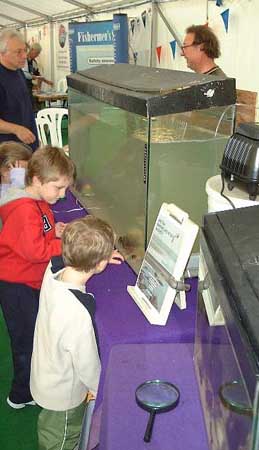 The
SHOREHAM FISH FESTIVAL on Coronation
Green, Shoreham-by-Sea,
West Sussex, was attended by 4,000 people if the sunshine as the high six
metre spring tide filled the river just before 1:00
pm. The British Marine
Life Study Society held an aquarium display
and despite technical problems with a very high plankton content in the
water (which meant the large wrasse could not
be displayed) the exhibits were well received by the younger age group.
The
SHOREHAM FISH FESTIVAL on Coronation
Green, Shoreham-by-Sea,
West Sussex, was attended by 4,000 people if the sunshine as the high six
metre spring tide filled the river just before 1:00
pm. The British Marine
Life Study Society held an aquarium display
and despite technical problems with a very high plankton content in the
water (which meant the large wrasse could not
be displayed) the exhibits were well received by the younger age group.
Picture
Gallery
5 August
2003
It
was the hottest day of the new millennium when the temperature reached
30.6° C at 5:54 pm
with a gentle breeze. Humidity fell to 39% so it was quite pleasant outside.
Not surprising with the warm weather, many people who are not at work and children on holiday made their way to the beach where the estimated sea temperature was 19° C, possibly rising to 21° C inshore over sand. Weever Fish are around and there were several reports of people being stung by this fish that lives in the sand with its venomous black dorsal fin sticking above the surface on which the bather may have the misfortune to step on.
After being sting by large Weevers the pain is described as excruciating for the first two hours after which it subsides and rarely causes permanent injury. The pain can be relieved by immersing the foot in hot water at 40° C. This fish is common on sandy coasts all around Britain.
11
June 2003
Herring
Gulls, adults and immature birds were
paddling at the water's edge at low tide whilst the Great
Black-backed Gulls remained stationery.
There seems more of these large Great Black-backed
Gulls staying around for the summer this year.
4 June
2003
Small Weever
fish were discovered in the shrimp net (push-net) haul in the sea off Widewater
beach. Weever fish are silvery with a black venomous fin and spines. The
can impart a nasty sting on the unwary and bare foot paddler over the sandy
shallows.
3 June
2003
The
famous Boar Fish,
Capros
aper, died after its aquarium sprung
a leak in the middle of the night. (It was caught in November
2002).
31
May 2003
Shoreham
bathed in a heat wave up to
24°
C for the opening of the Adur Festival and
Adur
World Oceans Day 2003 on Coronation
Green, Shoreham-by-Sea. About
3000 people attended the event that was steady and busy throughout.
Exhibits
included live fish and lobster in aquaria, colouring and badge-making,
whales
and dolphins, birds, shrimps, fish-tasting, touch-table, Shoreham shingle
beach flora and undersea colour photographs and videos.
A special thanks to all the participants, especially Len Nevell (British Marine Life Study Society) and Steve Trewhella (Marine Conservation Society). The inflated dolphin was provided by Steve Savage (Sea Watch Foundation).
Several groups had special exhibitions including the:
British
Marine Life Study Society including Shorewatch
(four exhibits)
West
Sussex County Council Countryside Unit
Sea
Watch Foundation (for Whales & Dolphins)
Sussex
Sea Fisheries District Committee
SeaSearch
(Undersea Biological Recording)
Shoreham
& District Ornithological Society
Sussex
Ornithological Society
Adur
World
Oceans Day 2003
10:00
am - 4:00 pm
Popular
Information File on Adur World Oceans Day
2003
Acrobat
Information File on Adur World Oceans Day
2003
5
November 2002
Collecting
a few rocks for aquarium props in fading light, a moonless evening under
torchlight, there were dozens of Squat
Lobsters, Galathea squamifera, and
at least one red-eyed Velvet
Swimming Crab,
Necora
puber. I thought that I picked up
two, but the following day, I noticed that the crab had pale blue eyes
and this I now think may be a different crab altogether, Liocarcinus
arcuatus, the Arch-fronted
Swimming Crab which I have never discovered
before, nor have I heard reported before from the shore. The
identity of this crab has been confirmed by Dr.
Reindert Nijland.
This
small specimen of this crab (carapace width 25 mm) had a heavy carpus on
both chelae, a rough carapace in chocolate brown, swimming legs
that were pointed, slower moving than Necora, with also are pronounced
creamy white underside, and at dusk that was only its fractionally different
movement that made it stand out from the Shore Crab.
There were no "teeth" between the eyes, and the carapace was in a straight
line between the eyes, with red antennae and antennules.
BMLSS
Intertidal Crabs
Lancing
Beach
2 November
2002
The
capture on rod and line by Peter
Weight (Lancing) of a Boar
Fish, Capros aper,
from Hove beach is the very first record of this fish caught from the shore
off Sussex. The books
say that this fish lives in depths of over 100 metres and there are no
seas of this depth on the English
side of the English Channel.
This
pretty little red and silver
rhomboidal fish about 55 mm long, excluding its caudal fin, large eye and
large protractile mouth, with a spiky first dorsal and vibrating second
dorsal and second anal fins (vibrating like the dorsal fin of a pipefish).
Although this fish is rarely caught, it is abundant in deepish water (on
the edge of the continental shelf in the western approaches of the English
Channel) and it is just that normal fishing methods do not capture this
small fish. All records and especially all live records from the
shore or on dives, and all Sussex records are newsworthy.
This
fish is thriving in the BMLSS private aquarium
(Shoreham-by-Sea). This fish is rarely on display
in British Public Aquaria and the only known display
of this fish was for several years at Mevagissey
Harbour Aquarium.
Previous
Sussex Record of a Boar Fish
Previous
Report from the Channel Islands
BMLSS
Boar Fish
 11
June 2002
11
June 2002
The
presence of Spiny
Spider Crabs, Maja squinado,
underneath the wooden groynes on Shoreham beach (TQ
216 047), south of Weald Dyke (road), is a
notable aspect of the wildlife fauna of Shoreham and little known. Although
it is the smaller crabs that are found at low
tide, these are still the biggest animals found between the tides.
In
captivity,
a female Spiny Spider Crab moulted
twice before 30 June 2002.
British
Marine Life Study Society
BMLSS
Rockpooling
Wet
Thumb (Marine Aquariology)
1
June 2002
A
huge one metre in diameter jellyfish with a humped appearance was discovered
washed up on
Shoreham beach due of south of Coronation Green. This is the species known
by several common names: Barrel Jellyfish,
Football Jellyfish, Root-mouthed Jellyfish, and with the scientific name
of Rhizostoma octopus. This
is an unusual sighting off the Sussex coast, but this year tens of thousands
have been seen off the coast of Cornwall, with many more washed up on the
coast of Devon and Dorset.
Other Reports
BMLSS Jellyfish
1 June
2002
Adur
WORLD
OCEANS DAY Exhibition at Coronation
Green, Shoreham-by-Sea.
 Adur
was one of the leaders in the United Kingdom when it presented an Exhibition
celebrating the official World Oceans Day. The event
took place on Saturday 1 June 2002
in Shoreham-by-Sea, on Coronation
Green (TQ 216050), adjacent
to the footbridge over the River
Adur, with the start of the Adur Festival.
Adur
was one of the leaders in the United Kingdom when it presented an Exhibition
celebrating the official World Oceans Day. The event
took place on Saturday 1 June 2002
in Shoreham-by-Sea, on Coronation
Green (TQ 216050), adjacent
to the footbridge over the River
Adur, with the start of the Adur Festival.
CLICK ON THE IMAGE FOR MORE INFORMATION
Adur
World Oceans Day Picture Portfolio 2002 (by
Ray Hamblett)
Adur
World Oceans Day 2002 Programme of Events
Adur
World Oceans Day 2001 Report
Adur
World Oceans Day Picture Portfolio
World
Oceans Day Smart Group
25
September 2001
Hundreds
of Dogwhelks,
Nucella lapillus, have colonised
the newish boulder sea defences on Southwick Beach. One dirty white specimen
was either attacking a Limpet or the Acorn
Barnacles that completed covered the limpet shell.
20
August 2001
The
long spring tide went out below Chart Datum
on Kingston beach and there was a meal of large
prawns Paleamon serratus.
The presence of a dozen very small Common Starfish,
Asterias
rubens, was unusual for this particular shore. There was an interesting
mixture of typical fish and invertebrate intertidal life, with hundreds
of very small (30 - 55 mm) first year Bullheads.
Full
Report
- 15
April 2001
I received a report via the RSPCA of three young sharks washed up on the beach at either Lancing or Worthing. A size was not mentioned. I assume these are Lesser-spotted Dogfish, Scyliorhinus canicula, which are so commonly washed ashore dead in all months of the year that they scarcely warrant a special mention. The specimen above was discovered intact near the Old Fort a couple of months ago, before it had been spotted by the gulls that scavenge along the strandline.
8 February 2001
Empty egg cases of the Thornback
Ray (left) and Dogfish (right) are found washed up on the strandline by
Andy
Horton and Ray
Hamblett.
Mermaid's
Purse (BMLSS Information)
1 August
2000
 A
most unusual appearance on Kingston
Beach was a solitary Snakelocks
Anemone, which reach their most easterly point of distribution
up the English Channel (northern coast) at Worthing,
with an occasional stragglers on the shore at Shoreham, and
A
most unusual appearance on Kingston
Beach was a solitary Snakelocks
Anemone, which reach their most easterly point of distribution
up the English Channel (northern coast) at Worthing,
with an occasional stragglers on the shore at Shoreham, and
almost
entirely absent (one record only in 100+ visits) from Brighton.
1 August
2000
The Marine
Wildlife Forum of the NE Atlantic commences.
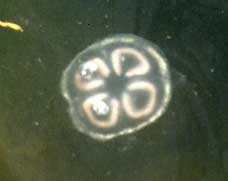 May
1999
May
1999
Moon
Jellyfish, Aurelia aurita, swarming in thousands in Shoreham
Harbour, Sussex. This jellyfish is common and widespread throughout
the oceans of the world and is common all around the coast of Britain.
It would not deserve a special comment if they had been recorded regularly
at this location before - they had been for about 4 years, but not in so
many numbers. The largest specimens reached 25 cm in diameter. In some
specimens the four rounded pinkish masses, which are the gonads could be
seen. An occasional specimen had 6 rings.
Rockpooling
Page
Zonation
on the Shore
Longshore Drift
Longshore drift occurs as a result of wave action. Propelled by the dominant south-west winds1 the wave (the swash) hits the shingle beach and moves the pebbles obliquely up the shore and the backwash returns the pebble at right-angles, the following waves repeating the process so that the pebbles gradually move along the shore. The larger pebbles are to be found higher up the beach as the swash is more powerful than the backwash. On Shoreham Beach the Environmental Agency interfere with the natural process by moving large amounts of shingle back to where they were washed away from, to protect the housing developments on the foreshore.
1The
prevailing winds over Britain are from the south-west. These propel the
waves on to the shore on both sides of the English Channel. However, on
other coasts the prevailing winds blow out to the sea and the dominant
waves that crash on to the shore come from other directions, e.g. from
the north-east on the North Sea coasts, causing longshore drift from north
to south.
Local Wildlife Links (SE England)
Adur
Valley Nature 2002
Adur
Valley Wildlife
Carmarthen
Bay Saltmarsh SAC
Dungeness,
Kent, England
Lancing,
Beach Green & the Shingle Beach (Ray Hamblett)
Orford
Ness: Coastal Ecology of a Shingle Bank (excellent references)
Ralph
Hollins Nature Pages (Chichester Harbour area)
Rye
Harbour Nature Reserve
Rockpooling
Page
Seashore
Page
Seashore
(Slide Show)
Shingle
Coast (Coastal Fringe of Shoreham Beach)
Shingle
Discussion Group
Shoreham-by-Sea
Wildlife Page
Sussex
Wildlife Web Sites
Tides
Wildlife
& Conservation Links (West Sussex)
World
Oceans Day 2002
|
|
|
|
|











